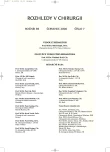Atypicky lokalizovaný hemangiom jater jako příčina dyspeptického syndromu
Atypically Localised Hepatic Haemangioma as a Cause of Dyspeptic Syndrome
Introduction:
Haemangioma is a benign mesenchymal tumor growing from the endothehum of blood vessels. Most hepatic haemangiomas are asymptomatic while symptomatic haemangioma are usually manifested by non-specific pain dyspeptic syndrome, quite rarely also by hemorrhage, or icterus Symptomatic haemangiomas or large haemangiomas with fast growth, are indicated for surgical treatment.
Case report:
The authors present a 50-year-old patient with chronic dyspeptic condition and pressure pain in the epigastria. USG, CT, MR, CT angiography and EUS have all shown two lesiones (haemangioma of the left hepatic lobe, a tumor in the left subphrenic area of uncertain origin). We proposed an operational solution, and, surprisingly, the finding was a single haemangioma (2 parts – intra- and extraparenchymatous – connected by a vascular bridge). We then performed left lobectomy.
Discussion:
In the diagnosis of haemangioma, MR is a method of choice with high specificity and sensitivity. Why did not it yield the correct diagnosis? The structure, the signal and the type of postcontrast enhancement of the second lesion corresponded to a haemangioma, but the extraparenchymatous location and also the considerable remoteness from the liver invalidated this possibility before operation. Regarding to the differential diagnostics of the lesiones in the subphrenic area, which according to the imaging techniques are not related to the hepatic parenchyma, it is advisable to consider the possibility of the incidence of pedunculated hepatic haemangioma.
Key words:
dyspeptic syndrome – hepatic haemangioma – MR as a method of choice – case report
Autoři:
J. Pudil 1; J. Martínek 2; T. Belšan 3; M. Ryska 1
Působiště autorů:
Chirurgická klinika 2. LF UK a ÚVN Praha, přednosta prof. MUDr. M. Ryska, CSc.
1; Oddělení gastroenterologie Klaudiánova nemocnice Mladá Boleslav, primář MUDr. J. Martínek
2; Radiodiagnostické oddělení ÚVN Praha, primář MUDr. F. Charvát
3
Vyšlo v časopise:
Rozhl. Chir., 2006, roč. 85, č. 7, s. 354-356.
Kategorie:
Monotematický speciál - Původní práce
Souhrn
Úvod:
Hemangiom je benigní mezenchymový nádor vyrůstající z endotelu krevních cév. Většina jaterních hemangiomů je asymptomatická, symptomatické hemangiomy se nejčastěji projevují nespecifickou bolestí, dyspeptickým syndromem, vzácně krvácením, či ikterem. K chirurgické léčbě jsou indikovány symptomatické hemangiomy, či velké hemangiomy s rychlým růstem.
Kazuistika:
Autoři prezentují 52letou pacientku s anamnézou chronických dyspeptických obtíží a tlakových bolestí v epigastriu. USG, CT, MR, CT-angiografie i EUS shodně zobrazila dvě ložiska (hemangiom levého jaterního laloku, tumor v levé subfrenické oblasti nejasného původu). Indikovali jsme operační řešení s překvapivým nálezem pouze jednoho hemangiomu (dvě části – intra- a extraparenchymatózní – spojené cévním můstkem). Provedli jsme levostrannou lobektomii.
Diskuse:
MR je v diagnostice hemangiomů metodou volby s vysokou specifitou i senzitivitou, proč tedy nestanovila správnou diagnózu? Struktura, signál a charakter postkontrastního sycení 2. ložiska odpovídaly hemangiomu, ale extraparenchymatózní uložení a značná vzdálenost od jater tuto možnost předoperačně nepřipustila. V diferenciální diagnostice ložisek v subfrenické oblasti, která podle zobrazovacích technik nesouvisí s jaterním parenchymem, je vhodné pomyslet i na pendulujicí jaterní hemangiomy.
Klíčová slova:
dyspeptický syndrom – hemangiom jater – MR jako metoda volby –kazuistika
Štítky
Chirurgie všeobecná Ortopedie Urgentní medicínaČlánek vyšel v časopise
Rozhledy v chirurgii

2006 Číslo 7
- Metamizol jako analgetikum první volby: kdy, pro koho, jak a proč?
- Specifika v komunikaci s pacienty s ránou – laická doporučení
- Léčba akutní pooperační bolesti z pohledu ortopeda
Nejčtenější v tomto čísle
- Atypicky lokalizovaný hemangiom jater jako příčina dyspeptického syndromu
- Laparoskopická Hellerova operace
- Duplikatura terminálního ilea – kazuistika
- Incizionální hernie – plastika podle Ramireze
